Published
on 25
Sep 2015
|
All rights reserved.
|
|
|
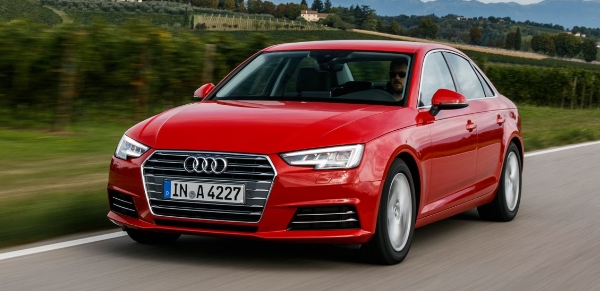
|
This
is the 5th generation Audi A4, or the 9th if you include its
predecessor Audi 80. Since the first 80 introduced in 1972, some 12
million units of the family have been sold worldwide. Moreover, it gets
more and more popular in recent generations, rising from an also-ran in
the class to one of the cars every buyer should consider. The 9th
generation continues this trend. In many areas it has been improved
considerably. However, as in the cases of many recent Audis, I am not
quite sure if its styling can be described as progress. At the first
glance, it looks as if a facelift of the old car rather than an all-new
design. While the hexagonal corporate grille and polygonal headlamps
are new, the rest of the car doesn’t differ much from the old. In fact,
it could look more conservative than its predecessor from some
angles, because its roof line gets straighter and its boot lid gets
flatter. Its conservative approach is a sharp contrast to the ones
taken by its rivals, especially Mercedes and Lexus. Perhaps it cares
too much about the Chinese market.
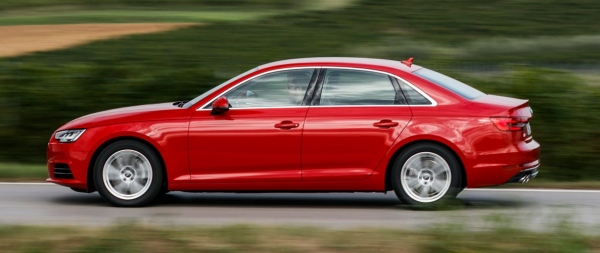
|
Dimension-wise, the
B9 model doesn’t differ much from its predecessor either. Measuring
4726 mm long, 1842 mm wide and 1427 mm tall, it is just marginally
longer and wider than the outgoing model, while the 2820 mm wheelbase
is barely 12 mm longer. However, I can’t help wondering how efficient
it is. Here, I am not just talking about the efficient use of fuel but
also the efficient use of materials, forms and technology. From its
slightly bland appearance you won’t believe it has managed to match
Mercedes CLA180 for a drag coefficient of 0.23, which means it is the
smoothest production car in the world. It achieves that with smooth
undertray and shutter grille but, unlike the Mercedes, without
sacrificing rear headroom. This is efficient.
Likewise, without resorting to an aluminum-intensive chassis it manages
to equal Mercedes C-class or even undercut Jaguar XE on scale. Look at
the picture below, you will see the use of aluminum in the monocoque
body is fairly limited. The majority of it comprises of high-strength
or ultra-high-strength steel, which is cheaper to source and cheaper to
assemble. Admittedly, the monocoque contributes to only 15 kg of weight
saving. Audi seeks more weight saving in areas costing less to do, such
as the aluminum-intensive suspensions (-13 kg), new electric power
steering (-3.5 kg), seats (-9kg), magnesium-casing manual gearbox,
hollow shafts and smaller clutch (-16 kg combined), lighter brakes (-5
kg)... as a result, an A4 1.4 TFSI weighs the same as a Mercedes C180.
It is also 90 kg lighter than its direct predecessor.

|
The new A4 sits on
an evolution of the existing MLB platform, or MLB Evo. Its 5-link front
suspension is vastly reworked with lightweight forged aluminum
links/knuckles, vibration-absorbing hydro-mounts and is mounted on a
stiffer subframe. Likewise, the new 5-link rear axle is lighter than
the old trapezoidal-link. There are 2 choices of suspension setup, one
stiffer to please motoring journalists who consistently rated the A4
below BMW 3-Series, and one softer to please the majority of customers.
Both can be optionally installed with adaptive dampers, which are
linked to the Audi Drive Select system. As always, front-wheel-drive is
standard on all models bar the most powerful ones, which are served
with 40:60-split Quattro system.
At launch there are 7 engines on offer. The base A4 employs 150 hp 1.4
TSI ACT engine which is popular in Volkswagen group. Most customers are
likely to opt for the mid-range 2.0 TFSI in two states of tune (190 hp
or 252 hp), or the 2.0 TDI with 150 hp or 190 hp (don’t worry, it is
the new EA288 instead of the emission-cheating EA189). At the top, the
3.0 TDI V6 offers either 218 hp or 272 hp and chunks of torque. All
diesel engines are now EU6-compliant, thanks to AdBlue urea addictive.
The most interesting to me is the 190 hp 2.0 TFSI, because its
operation can switch between Otto cycle and fuel-saving Miller cycle.
In the latter mode, it utilizes the second cam set of Valvelift system
to close the intake valves earlier, thus reduces the effective
displacement to about 1.4 liters. With a CO2
rating of 109 g/km, it is the closest thing to replace diesel. Other
engines are expectedly good.

|
Unlike the
exterior, the cabin is a revolution. Its new dashboard design looks
cool, high-tech and high-quality. I think it sets new standards for
this class, beating even Mercedes C-class. The optional, 12.3-inch TFT
instrument screen comes directly from Audi TT, so it may double as
sat-nav display. The cabin also enjoys more space. Front passengers are
given 11 mm more shoulder room and 24 mm more headroom, while rear
passengers have 23 mm more legroom. 4 adults should find plenty of
room, although 5 could be a bit tight.
Cruising on motorway, this cabin is what a relaxing place to spend
time! There’s precious little wind and road noise thanks to the stiffer
body and improved insulation, including double-glazing front windows.
The engine, no matter petrol or diesel,
is remarkably quiet on steady cruise. Ride quality is much improved
from the old car, suppressing bumps and expansion joints far more
effectively, although Mercedes or Jaguar seemed to have an edge when
dealing with rougher surfaces. Refinement also extends to the slick
6-speed manual gearbox (a vast improvement from the old unit) and the
class-leading 7-speed S Tronic twin-clutch.
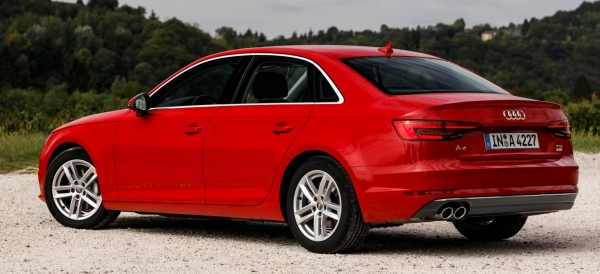 |
Attacking corners,
you will be amazed that the Audi’s handling is no longer troubled by
strong understeer. Over the last couple of generations it had been
cutting understeer gradually and now it steers almost as neutral as its
rear-drive rivals. Although the engine still occupies the front
overhang, its reworked front suspensions and steering makes it feel
less nose-heavy. The front wheels grip harder and the nose follows your
commands more faithfully.
However, the A4 still fails to match the dynamics of its rear-drive
rivals, especially Jaguar XE, Cadillac ATS and the updated 3-Series.
Its steering lacks the precision and feel to engage its drivers. It
rolls more in a corner, and ultimately it doesn’t adjust its orbit when
you back off mid-corner or try to have its tail unstuck. Its handling
remains one-dimensional, which is all about grip and security. Quattro
or front-wheel drive, this character is deeply printed on its DNA.
Perhaps that is why all serious contenders for dynamics laurel opted
for longitudinal engine and rear-wheel drive. Before the Audi makes
that switch, which is unlikely in the foreseeable future, it will be
hard to fight for the class leader title, even
though it does many other things brilliantly.
|
Verdict:     |
Published
on 16
Jun 2016
|
All rights reserved.
|
|
Audi S4
|
|
8 years ago, Audi
declared supercharged V6 was the best engine configuration for its S4
after it had
experimented also naturally aspirated V8 and turbocharged V6. Now it
eats its own words by
adopting V6 turbo on the new generation S4! If you doubt if it is
really better, read the following numbers:
- Maximum
power:
354 hp, an increase of 21 hp from the outgoing supercharged V6.
- Maximum
torque:
369 lbft, up 45 lbft.
- Rev at
which max
torque is generated: from 1370 to 4500 rpm, vs 2900-5300 rpm.
- Fuel
economy:
37.6 mpg combined, up from 29.1 mpg.
- Engine
weight:
172 kg, down 14 kg.
Such a sizable, all-round improvement made me speechless...
More research into this motor will find it is probably the
most advanced production V6 currently on offer. Codenamed EA383, it is
believed to
be part of the new modular V6 / V8 family jointly developed by Audi and
Porsche, which has been unveiled recently by Porsche in the form of
4.0-liter
V8. Naturally, the Audi V6 shares the V8's 90-degree architecture to
allow it to be built on the same production line. This
necessitates a balancer shaft to be added at the center of the block,
just above the crankshaft, to cancel vibration. It also shares the
reverse-breathing architecture with the V8, which means the exhaust
manifolds exit from the inside of the V and feed the turbocharger,
which is also located in the V, through very short paths. Whereas the
V8 employs twin-turbo, the S4 engine makes do with a single
turbocharger (twin-turbo should be reserved for the RS4, of course). It
is a twin-scroll turbocharger. Each of the scrolls is fed by the 3
cylinders of each bank in order to minimize exhaust gas interference
thus improve turbine response. In addition to the relatively small
turbine and very short exhaust manifolds, no wonder the engine can
deliver maximum torque from merely 1370 rpm, which is just 670 rpm
above idle! Turbo lag? There is hardly any!
Surprisingly, the V6 shares the bore / stroke dimension of 84.5 x 89.0
mm with the outgoing supercharged V6 rather than the 86 x 86mm of
Porsche V8, so its displacement is exactly the same as its predecessor
at
2995 c.c. However, its compression ratio is lifted from 10.3:1 to
11.2:1 to enhance combustion efficiency. Like the recent 190 hp 2.0TFSI
engine, the V6 is capable to run in Miller cycle under part load to
save fuel. This is implemented by Audi’s Valvelift system on the intake
camshaft, whose second set of cams close the intake valves earlier and
therefore reduce the effective intake stroke. At higher load where more
power is demanded, it reverts to Otto cycle combustion and the full
11.2:1 compression ratio. No wonder fuel consumption is reduced by as
much as 23 percent. Besides, the new engine cuts cold-start emission by
separating the water cooling circuits of cylinder heads and block, so
that the heads can be warmed up quicker.
No question this is a good engine. Working in tandem with the ZF
8-speed Tiptronic transmission and Quattro 4-wheel-drive system, the S4
is capable to do 0-60 mph sprint in 4.5 seconds (Avant takes an extra
0.2s), which beats not only BMW 340i (4.9s) but also Mercedes C43
4matic (4.7s). Drinks less and runs faster than rivals, well done!
Unfortunately, the rest of the car is less appealing. Exterior styling?
Somewhat boring and somewhat bad taste (mainly its face). Interior?
Extremely advanced and high quality, but so is the lesser A4! Aural
excitement? The exhaust note is subdued and not very interesting. The
gearbox? No more manual box or dual-clutch S tronic this time. Even
though the Tiptronic is smooth and rapid, its gearshift is neither as
responsive nor as satisfying as the dual-clutch when you are in mood to
have fun. The steering? Light and direct but short of feel.
The new S4 have all kinds of ingredients to succeed, ranging from a
Torsen C Quattro system (40:60 split normally) to optional active rear
differential, from a 23 mm lower and stiffer suspension tuning to
optional magnetorheological adaptive dampers. But wait, aren’t them
already available to the last S4? Yes, that’s the problem. Audi spent
little effort to improve its handling. It just lets the new A4’s
superior refinement to erode the last S4’s fine dynamics and
communication (it got a 5-star rating and matched BMW, remember). The
result is a car excels more in comfort than driving excitement. No
matter the steering, the gearshift and suspension, it has softened the
edge and added an extra layer of isolation. Even that excellent
turbocharged motor cannot claim a throttle response as instantaneous as
the old supercharged V6. In short, the S4 is too civilized and too cold
to inspire keen drivers. It lacks the tactile feel and deep engagement
you would find in a 340i, C43 or Jaguar XE S. Faster, more refined and
efficient it might be, it is not a great driver's car.
|
Verdict:    |
Published
on 15
Dec 2017
|
All rights reserved.
|
|
Audi RS4
|
|
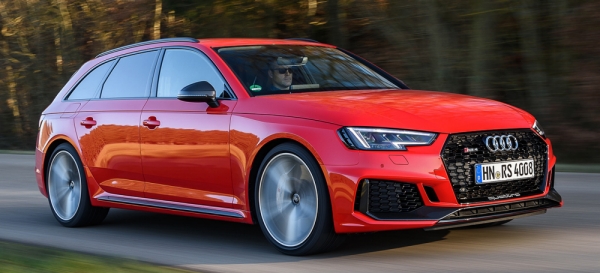
|
|
Turbocharged
V6 might be less frenetic, but it suits the character of the Audi
estate.
|
|
This is the 4th generation
Audi RS4. The original car was born 17 years ago. It employed a mighty,
380-horsepower version of the company’s 2.7-liter twin-turbo V6, far
exceeding the contemporary BMW M3 and Mercedes C55 AMG. It was the car
that lifted Audi above its German rivals in the performance world. The
next two generations RS4 were even better, as they switched to a
high-revving (8250 or 8500 rpm) 4.2-liter V8, again setting new
standards for its rivals to follow. The RS4 has never been renowned for
balance or feedback, but no one doubted it's real-world performance
(thanks partly to Quattro) as well as the marvelous engines.
Under the pressure of emission reduction, the new car has reverted to
twin-turbo V6. Not only it loses 1.3 liters of capacity, it is actually
100 c.c. smaller than the single-turbo 3.0-liter unit serving the
lesser S4, strangely. Nevertheless, I suppose you have already known
that, because the engine is derived from Porsche and it has been using
on the RS5 as well. If you are not familiar with its technical
specifications, please read the RS5 report
first. In short, it levels with the old V8 in terms of top end power
(450 hp), but it offers overwhelming torque at any revs, which peaks at
442 lbft from 1900-5000 rpm. It also helps the RS4 to reduce CO2
emission from 249 to 200 grams per kilometer.
For sure, the turbocharged V6 feels a lot stronger on the road thanks
to that tremendous mid-range torque. 0-60 mph can now be reached in 4
seconds flat, half a second quicker than the old car – partly helped by
the fact that the new A4 platform cuts 80 kg from its kerb weight. You
no longer need to wait for the rev climbs to sky-high rpm to get the
power you want. Turbo lag is subtle, while throttle response is
reasonably quick. With the optional sport exhaust equipped, the engine
produces exciting sound, too, although nowhere near the old V8 singing
at 8000-plus rpm. Purists still prefer the V8 for its linear output and
sweet-revving manner, but it is undeniable that a torquey engine suits
a premium performance estate better. For the same reason, Audi has
replaced its in-house 7-speed S tronic twin-clutch gearbox with the
popular ZF 8-speed automatic. Its torque converter delivers smoother
shifts, but performance seems to suffer no losses.
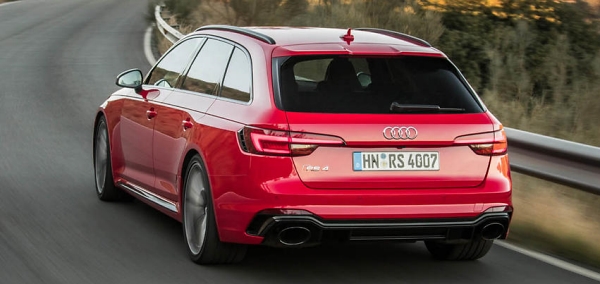
|
|
While
it is not the last word for driver engagement, the gaps from its rivals
have been narrowed considerably.
|
|
Weighing 31 kg less than the V8, the V6 also improves chassis balance.
On the other hand, the Avant body of the RS4 (no saloon, as Audi
decided RS5 Sportback would be more suitable) shifts more weight
towards the rear axle, no wonder the RS4 feels a tad better balanced
than the coupe. Both cars employ much the same underpinnings, such as
the Quattro system with crown-gear
center differential (40:60 torque
split in normal situation), the DRC adaptive suspension system that
links diagonal suspensions hydraulically to reduce pitch and roll, and
the active rear differential. You can opt for active Dynamic steering
(better not to), expensive ceramic brakes and lightweight milled alloy
wheels. Outside, the RS4 has an angrier front end design, but the
strongest implication to its enhanced performance has to be the 30mm
wider wheel arches, which are necessary to house its 275/30ZR20 rubbers.
Just like the new RS5, you will find this RS4 has greatly improved ride
quality and refinement from its predecessor. Leave it in Comfort mode
and it will glide over most roads with ease. It is finally an estate
that you will be happy to use every day. Switch to Dynamic mode, it
becomes much firmer, but body control also becomes much tighter. You do
need this mode to tame its inherent pitch and match the dynamic quality
of its rivals, but if you are in mood to attack, the loss of ride
comfort matters little. The RS4 still fails to match the Alfa Giulia QF
or M3 for balance and agility, or the C63 S for its engaging power
slide and mad engine, but it strikes back with superior grip and
traction, thanks to 4-wheel drive and those massive tires. Most
important, its chassis balances nicely, at least good enough for a
performance estate, unlike some earlier RS cars that were prone to
terminal understeer. Push it hard enough on a circuit and you can even
induce a little bit oversteer, when up to 85 percent torque is directed
to the rear wheels by the crown-gear differential. The steering is not
very communicative, but again
it is improved to acceptable level.
In many aspects the new RS4 is a vast improvement – performance, ride
and balance in particular. While it is still not the last word for
driver engagement, the gaps from its rivals have been narrowed
considerably. I suppose this could have been narrower still if it kept
using a naturally aspirated V8. However, this civilized character
suits an estate car with Audi badge, more so than the RS5 Coupe.
|
Verdict:     |
|